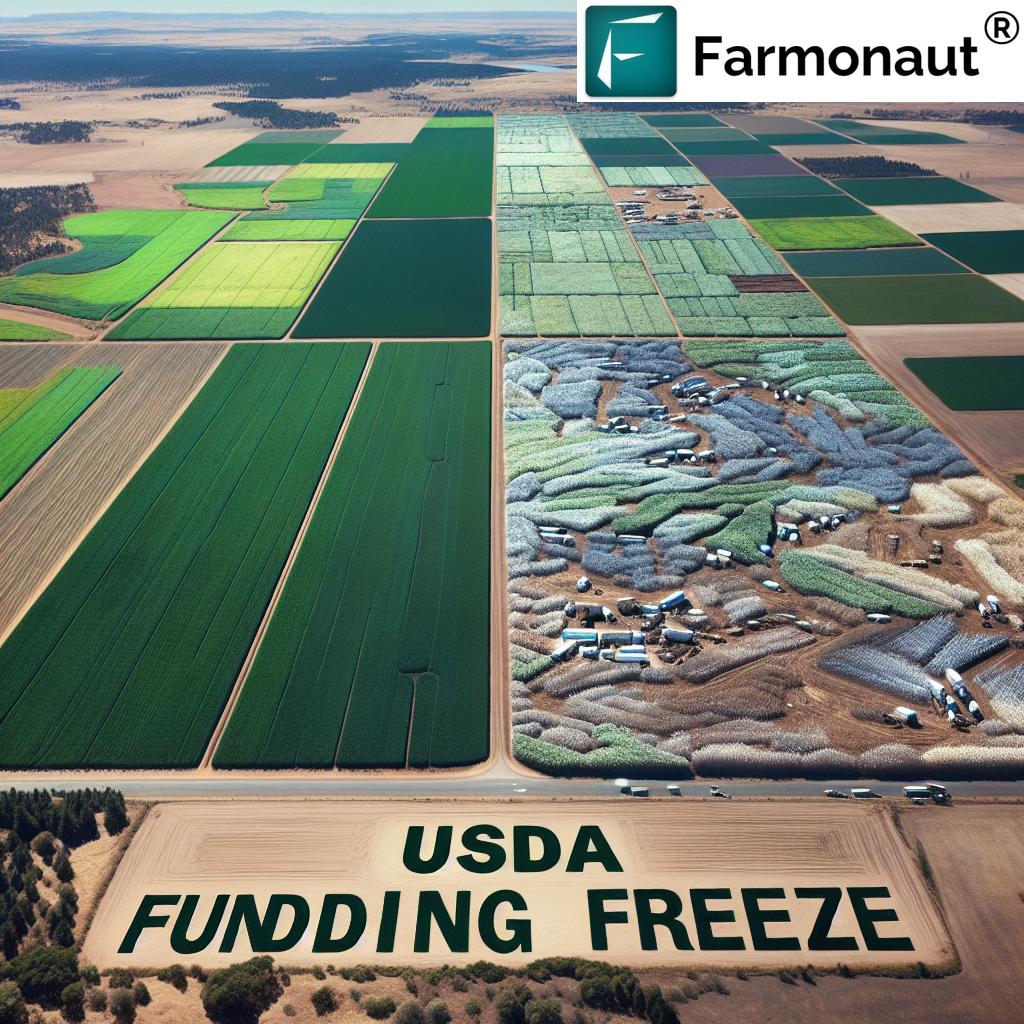Table of Contents
- Key Trivia about Medium Grain Rice Yield
- Introduction: Why Study 2005 Medium Grain Rice Yield NASS Pounds Per Acre?
- Historical Context: 2005 Medium Grain Rice Yield Data
- Comparative Trend Table: 2005 & 2025 Medium Grain Rice Yields
- Agricultural Factors Influencing 2005 Medium Grain Rice Yield
- Technological and Agronomic Advances Since 2005
- The Importance of Yield Data (Pounds Per Acre) in Modern Rice Production
- Climate and Environmental Challenges: Adapting for 2025 & Beyond
- Relevance to Modern Agricultural Policy and Market Economics
- Future Trends & Sustainable Practices for Medium Grain Rice
- Farmonaut’s Role: Satellite Technology for Crop Monitoring & Sustainable Yields
- Frequently Asked Questions (FAQ)
- Conclusion: Lessons from 2005 for a Resilient 2025
2005 Medium Grain Rice Yield NASS Pounds Per Acre Trends: Data, Insights, and Sustainable Practices for 2025
The 2005 medium grain rice yield NASS pounds per acre statistics provide a crucial benchmark in understanding the evolution of rice cultivation in the United States, particularly in top-producing regions like California, Arkansas, and the southern states. As we advance into 2025, reflecting on this data allows us to evaluate the impact of technological and agronomic advances, review lessons learned, and chart a path toward more sustainable and efficient rice production.
This comprehensive analysis draws from historical data recorded by the National Agricultural Statistics Service (NASS), exploring how yields were influenced by factors such as irrigation, advances in seed genetics, pest management, and environmental conditions. We’ll uncover important agricultural trends, compare key regions, and discuss the ongoing relevance of these benchmarks for improving crop yields in 2025 and beyond.
Whether you’re a farmer, policymaker, researcher, or agri-technologist seeking insights into medium grain rice yield trends, this post will arm you with data, context, and actionable guidance.
Historical Context: 2005 Medium Grain Rice Yield NASS Pounds Per Acre
The 2005 medium grain rice yield NASS pounds per acre records represent a pivotal phase in the evolution of commercial rice farming. Medium grain rice—with its distinct size and versatile cooking properties—remained a preferred crop variety in various regions, particularly California, Arkansas, and the southern United States. Consumer preference for its plumper, more tender grains helped shape market demand and incentivized regional agricultural practices.
NASS (National Agricultural Statistics Service) played a critical role, gathering and compiling historical yield data to guide farmers, agricultural policymakers, and industry researchers. In 2005, U.S. medium grain rice yields were averaged and expressed as pounds per acre, generally falling between 6,000 and 7,200 pounds per acre depending on region, management practices, and environmental factors.
- California: Consistently achieved the highest medium grain rice yields, due to fertile soil, advanced irrigation infrastructure, and a favorable Mediterranean climate.
- Arkansas & The South: Moderate yields were observed, reflecting differences in water resources, soil types, and exposure to diverse climate challenges.
This snapshot provides a solid foundation for evaluating trends over time—aiding our understanding of how the sector has evolved and where opportunities for further improvement remain.
Comparative Trend Table: 2005 Medium Grain Rice Yield NASS Pounds Per Acre Versus 2025 Projections
| State/Region | 2005 Yield (lbs/acre, est.) | National Average (lbs/acre, est.) | Notable Agricultural Advances in 2005 | Projected 2025 Yield (lbs/acre, est.) |
|---|---|---|---|---|
| California | 7,500 | ~7,200 | Advanced flood irrigation, high-yielding medium grain varieties, integrated pest management |
8,250 |
| Arkansas | 6,600 | Improved fungicides, soil fertility practices, laser leveling for better irrigation |
7,300 | |
| Louisiana (Southern US) | 6,200 | Diverse seed selection, rotational cropping, mechanized planting |
6,800 | |
| Mississippi | 6,400 | Irrigation scheduling, pest resistant varieties, early disease detection |
7,050 |
Agricultural Factors Influencing 2005 Medium Grain Rice Yield (NASS Pounds Per Acre)
To fully understand the 2005 medium grain rice yield NASS pounds per acre trends, it’s vital to explore the factors that shaped production outcomes during this period. Medium grain rice output—whether in California, Arkansas, or the southern U.S.—was influenced by a complex interplay of natural and human-driven forces:
- Seed Variety & Genetics: The use of regionally-adapted, medium grain rice seed varieties with varying degrees of disease resistance and yield potential.
- Soil Fertility Management: Utilization of synthetic and organic fertilizers, soil amendment protocols, and regular soil health testing.
- Irrigation Efficiency: Adoption of water management technologies (notably flood irrigation in California and southern states), pump systems, and field leveling for better distribution.
- Pest & Disease Management: Early detection, chemical controls, and crop rotation to minimize pest and disease pressure.
- Climate Conditions: Weather events—heat, drought, hurricanes—directly affected annual yield potential, especially across southern states.
- Farming Practices: Level of mechanization, labor availability, and adherence to best agronomic practices.
By 2005, these factors collectively influenced medium grain rice output and set a benchmark for later technological advances in productivity and sustainability.
Technological and Agronomic Advances Since 2005: Raising Medium Grain Rice Yield NASS Pounds Per Acre
Since 2005, the rice industry—especially in the United States—has witnessed an immense benefit from innovation. Industry leaders, researchers, and farmers have adopted a variety of modern management practices and novel technologies to boost yields and foster sustainable practices:
Key Innovations Elevating Medium Grain Rice Yield (2005–2025)
- Genetic Improvements: Breeding programs have developed higher-yielding, disease-resistant, and drought-tolerant varieties. These improved medium grain types offer higher genetic potential and better adaptability to diverse environmental conditions.
- Precision Agriculture: The use of GPS, drones, and satellite imagery (NDVI, vigor mapping) allows precise monitoring of crop health, targeted nutrient application, and more efficient irrigation. This reduces input waste while maximizing per acre yield.
- Irrigation Improvements: The transition to efficient water management—including advanced pumping technologies, soil moisture sensors, and water recycling—has cut water use without reducing productivity.
- Integrated Pest & Nutrient Management: The integration of biological controls, regular soil testing, and balanced fertilizer programs helps prevent yield loss while maintaining soil health.
- Climate Adaptation: Modern farming has begun to account for variable weather, using predictive analytics and risk management strategies to maintain output despite climate change.
- Digitized Data Management: Platforms collect, store, and analyze yield data to inform future agronomic decisions and optimize farm operations.
Discover how global farmers are using large scale farm management tools to integrate satellite monitoring, precision farming, and yield optimization—driving 10-20% improvements in rice and grain output.
The Importance of Yield Data (Pounds Per Acre) in Modern Rice Production
Yield data—expressed as pounds per acre—remains the most fundamental metric for evaluating efficiency, profitability, and environmental impact in rice cultivation. For medium grain rice, this measurement is essential for:
- Benchmarking Improvements: Historical trends (like those recorded by NASS in 2005) offer a direct comparison to current practices—helping to measure progress.
- Resource Allocation: Decision makers use yield statistics to allocate fertilizers, irrigation water, and manage soil health for maximum efficiency.
- Market Forecasting: Yield per acre data shapes projections on supply and pricing for both farmers and global markets.
- Sustainability Monitoring: Pounds per acre can be correlated to carbon input, water savings, and other sustainable agricultural indicators.
- Government and Financial Planning: Banks and insurance agencies (Crop loan & insurance solutions) refer to historical and current yield data for creditworthiness and risk assessment.
This robust data-driven approach allows farmers and policymakers to understand and respond to changes more proactively—promoting higher productivity while preserving environmental resources.
Climate and Environmental Challenges: Adapting for 2025 & Beyond
Climate variability remains a persistent threat to medium grain rice yields. From droughts in California to increased storms in the south, farming conditions in traditional rice-producing states have evolved. Yield impacts arise from:
- Water Scarcity: Reduced snowpack and unpredictable rainfall disrupt traditional irrigation.
- Soil Health Degradation: Intensive agriculture, without proper rotation or cover cropping, depletes vital nutrients—lowering yield potentials.
- Intense Weather Events: Hurricanes and heatwaves directly threaten crop establishment and harvest.
- Disease & Pest Pressure: Changing climate conditions increase the prevalence and distribution of rice pests and diseases, requiring vigilant management practices.
Adopting environment-friendly methods like carbon footprinting enables growers and agribusinesses to track greenhouse gas emissions and comply with sustainability reporting norms—vital for resilient rice production systems in 2025.
Relevance to Modern Agricultural Policy and Market Economics
Understanding historical yield benchmarks, specifically the 2005 medium grain rice yield NASS pounds per acre data, is indispensable for policymakers and market analysts. These records do the following:
- Set realistic national and regional yield targets for future agricultural programs.
- Guide government support efforts (insurance, subsidies, infrastructure development) toward the most vulnerable farmers or regions.
- Inform international trade strategies—as the U.S. is a major exporter of medium grain rice.
- Facilitate technological investment in crop breeding, irrigation, and digital agriculture for maximum economic return.
- Promote market stability by stabilizing supply projections.
By 2025, the importance of accurate, accessible historical yield statistics (as provided by NASS) has only increased—helping ensure both food security and equitable market opportunities for all stakeholders.
Future Trends & Sustainable Practices for Medium Grain Rice Yields
Moving forward, the pressure to maximize productivity must be carefully balanced with the stewardship of soil, water, and environmental health. The philosophy of sustainable intensification—doing more with less—guides future agricultural programs for medium grain rice yields in the United States and globally.
- Adoption of satellite and AI technologies (such as those delivered by Farmonaut) for real-time crop health monitoring, water optimization, and early pest detection.
- Emphasis on rotational cropping and minimal tillage to support soil fertility and long-term productivity.
- Expansion of blockchain-based traceability (learn more here) in rice supply chains to ensure transparency and build market confidence.
- Increased use of resource management for fleet optimization and logistics—explore fleet management tools to streamline harvests and reduce operational costs.
- Frequent environmental impact monitoring—including carbon tracking and compliance with upcoming regulations.
These forward-looking trends allow for higher, more reliable yields without degrading the environment—a necessity as the impacts of climate change and population growth converge.
Farmonaut’s Role: Satellite Technology for Crop Monitoring & Sustainable Yields
As we strive to increase 2005 medium grain rice yield NASS pounds per acre benchmarks in 2025 and beyond, the need for real-time agricultural intelligence and advanced monitoring solutions has never been greater. Farmonaut, a pioneering satellite technology company, stands at the forefront of this transformation—offering affordable, accessible, and scalable satellite-driven insights and management tools to the agriculture sector worldwide.
How Farmonaut Empowers Sustainable, Profitable Rice Farming:
- Satellite-Based Monitoring: By leveraging multispectral satellite images, Farmonaut enables farmers and businesses to monitor rice crop health, soil conditions, and water stress at scale. NDVI and AI-powered analytics help detect vegetative vigor, drought damage, or pest outbreaks early.
- Jeevn AI Advisory System: Our AI-driven tool provides real-time strategies, weather forecasts, and customized field recommendations, boosting per acre yield and minimizing losses.
- Blockchain-Based Traceability: Farmonaut’s blockchain solutions guarantee transparent rice supply chains and protect against fraud—making food safety and compliance seamless.
- Resource & Logistics Management: Advanced fleet management optimizes machinery and transport, reducing operational costs and ensuring timely, efficient harvests.
- Environmental Impact Solutions: Real-time tracking of environmental parameters, including carbon footprinting and emissions, supports sustainable agricultural practices and compliance.
- Subscription Model: We offer web, Android, and iOS platforms, plus full-featured API access (API docs here) to integrate satellite-based intelligence into any agri-business operation—all at affordable, scalable pricing below.
Get started today: Open Farmonaut App
Want developer integration? Review our API documentation and build your own custom solutions with our real-time agricultural data.
Frequently Asked Questions (FAQ): 2005 Medium Grain Rice Yield NASS Pounds Per Acre Trends
Q1: What was the national average medium grain rice yield in 2005?
The national average, according to NASS statistics, was approximately 7,200 pounds per acre, with some states like California exceeding 7,500 pounds per acre.
Q2: Why is pounds per acre used as the standard metric?
Pounds per acre allows farmers, researchers, and policymakers to compare rice yields effectively across different regions, monitor improvements, and assess the impact of technological or agronomic advancements.
Q3: How have modern technologies improved yields since 2005?
Advances in seed genetics, satellite technology, AI-driven crop management (see Farmonaut app here), improved water management, and data-driven pest control have all contributed to higher, more sustainable yield outcomes.
Q4: What are top sustainable practices for 2025?
- Precision agriculture (see large-scale farm management here)
- Blockchain traceability (learn about product traceability)
- Carbon footprint tracking (read more)
- Integrated pest and nutrient management
- Advanced irrigation systems
Q5: Where can I access latest crop monitoring API for rice yield insights?
Use Farmonaut’s API for real-time, satellite-based agricultural insights and yield monitoring.
Conclusion: Lessons From 2005 For a Resilient, Productive 2025
The 2005 medium grain rice yield NASS pounds per acre statistics remain crucial as both a historical benchmark and an ongoing reference point for sustainable development.
Key takeaways:
- 2005 provided a solid productivity foundation for evaluating the impact of genetics, irrigation, and climate on relative yields across major rice-producing states.
- Since 2005, major advances in technology—from satellite monitoring and AI-driven management (see Farmonaut App) to transparent supply chains—have enabled the industry to pursue both higher productivity and stricter environmental stewardship.
- As we look toward 2025 and beyond, embracing these lessons, tools, and sustainable practices is essential for resilient food systems and secure livelihoods—both in the United States and worldwide.
Explore Farmonaut to empower your operation for the next generation of data-driven, environmentally conscious rice farming.














